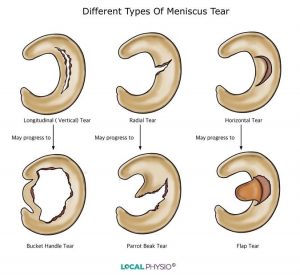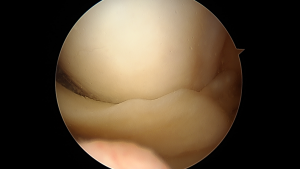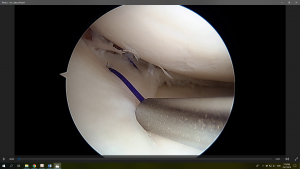Meniscus Injury – Ouch!! My shock absorber….
Posted on August 3rd, 2018. Filed under: Articles
Introduction
Meniscus are two important structures in the knee which provides both stability as well as to function as “shock absorbers” to the knee. The meniscus is crescent-shaped and helps deepen the knee articulation.
Meniscus injury
The meniscus, due to its function, undergo a lot of stress and is prone to injuries. Usually these injuries come in the form of sports injuries but it can also happen in falls, twisting injuries or degenerative (wear and tear) injuries. Injuries can be divided to:
1. Acute injury – sports, accident, fall. Where the mechanism of injury causes a tear in the meniscus
2. Chronic injury – degenerative. This is usually due to wear and tear. Occurs in older age group but can be
accelerated due to other pathology in knee such as associated ACL injury or previous fractures in and around
the knee
Tear Pattern
There are many types of tear pattern which can occur in a meniscus injury. Certain tear pattern may be treated conservatively however certain tear pattern such as bucket handle tear, radial tear and large parrot beak tear will require surgery especially if it causes symptoms.
Symptoms of meniscus tear
You might feel a “pop” when you tear a meniscus. Most people can still walk on their injured knee. Many athletes keep playing with a tear. Over 2 to 3 days, your knee will gradually become more stiff and swollen. The most common symptoms of meniscus tear are:
• Pain
• Stiffness and swelling
• Catching or locking of your knee
• The sensation of your knee “giving way”
• You are not able to move your knee through its full range of motion
Without treatment, a piece of meniscus may come loose and drift into the joint. This can cause your knee to slip, pop, or lock.
Treatment
Initial treatment is aimed at reducing swelling and pain. This is done using the RICE therapy:
R: Rest
I: Ice
C: Compression
E: Elevation
Consult your doctor where he/she will evaluate you knee by doing certain test to determine the extent of injury and what structures are injured. Some meniscus injury will be associated with other injuries such as ACL, medial collateral ligament or cartilage injury. He/she would also order a series of radiological examination such as an X-ray and an MRI. How your doctor treats your tear will depend on the type of tear you have, its size, and location.
Non-Surgical
If your tear is small and on the outer edge of the meniscus, it may not require surgical repair. As long as your symptoms do not persist and your knee is stable, nonsurgical treatment may be all you need. Rice therapy and non-steroidal anti-inflammatory medicines like aspirin and ibuprofen will help reduce pain and swelling.
Surgical
Surgery is indicated if you have locking symptoms, instability or if your symptoms persist with non-surgical treatment. Surgery is done arthroscopically (key-hole surgery). Repair of the tear is currently the best option whenever possible, this is to preserve the function of the meniscus, however removal of small or irreparable fragment may also be done to reduce the symptoms in certain cases.
Physiotherapy
This usually follows after healing in both non-surgical and surgical treatment of meniscus tear. Rehabilitation time for a meniscus repair is about 3 months.
Recovery
Meniscus tears are extremely common knee injuries. With proper diagnosis, treatment, and rehabilitation, patients often return to near their pre-injury abilities.
This article is by Dr Leong Wan Hee, Orthopaedic Surgeon (with a sub-specialty in Sports Injuries) at Timberland Medical Centre.
*The information in this article is not intended to replace a one-on-one relationship with a qualified health care professional and is not intended as medical advice to diagnose or treat a health problem or disease. You should consult your health care provider if you have or suspect you may have a health problem.



